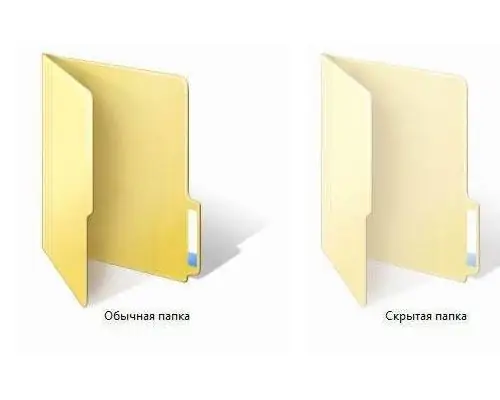Hidden files and hidden folders under standard settings of the Windows operating system are not displayed on hard drives and connected storage media. In order to access them, you need to make them visible.

What are hidden files and folders for?
The most common hidden files are system files and folders. The operating system hides such files for security reasons, because the user can, through negligence or ignorance, delete or change any of the files necessary for the normal functioning of the system as a whole, which can lead to serious consequences: from errors to complete system crash. By hiding files, Windows shields itself from the temptation of the user.
Some applications and programs sometimes hide their files from users for the same reason. They hide their own files and folders and the users themselves, when they do not want anyone to find this data.
A hidden file looks different from a regular file. When the display of hidden files and folders is enabled in the system, you can see that the icons of hidden folders or the names of hidden files look semi-transparent.
How to see hidden files and folders in Windows XP
You can show hidden files and folders in two ways - through the "Control Panel" or through "Windows Explorer".
1. Display through the "Control Panel". You need to go to the "Control Panel", this is done through the standard "Start" menu: "Start" - "Control Panel". In the window that opens, in the top menu, click the "Service" item, in the drop-down menu, click on "Folder Properties". The properties window will open, in which you must select the "View" tab. In this tab, in the window of additional parameters, select the item "Hidden files and folders" and put a tick in front of "Show hidden files and folders". Save the changes - click "Apply" and "Ok".
2. Display through "Windows Explorer". We go into Explorer: double-click to open the "My Computer" item, or simultaneously press the Win and E keys. In the top explorer menu, select "Service" and then proceed by analogy with the first item: select "Folder Options", then "View", look for item "Hidden files and folders", click "Show hidden files and folders", "Apply", "Ok".
After the performed manipulations, the files and folders hidden until this moment become visible to the user and you can work with them in the same way as with ordinary files. However, there is a way to work with hidden files and folders without making them visible on the system. They can be searched for and opened using any file manager, for example, using the popular Total Commander.
To do this, open the file manager, select the "Configuration" item, click the "Settings" section. A two-part settings window will open. In the left part of the window, look for the item "Panel Content". By clicking on it, we see in the right part of the window a list of options, among which we are looking for "Display files" and put a tick in front of "Show hidden / system files", then click "Apply" and "OK".






